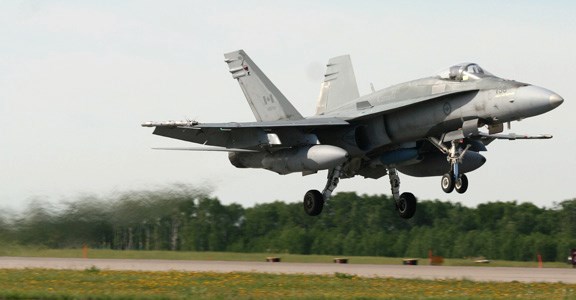LAKELAND - CF-18 fighter jets and pilots from CFB Cold Lake are part of an effective “toolbox” of weaponry involved in recent NORAD responses against unidentified objects floating across Canadian airspace, says one of Canada’s top military officials.
Major General Paul Prévost, the director of staff with the Canadian Forces Strategic Joint Staff confirmed to local media this week that jets from 4Wing were scrambled to assist the US Air Force on a high altitude operation over the Yukon on Feb. 11. The incident, a joint operation within the North American Aerospace Defence Command, was to intercept an unidentified floating object.
“Those F-18s were sent to participate. They have the capability to participate in the operation… they were sent to continue the operation should the US not be able to continue any further as it transited further into the Canadian airspace,” he said.
The object over the Yukon was one of four recent unidentified objects that have floated through Canadian and American airspace since early February. All four objects have been shot-down by NORAD aircraft.
The unidentified object over the Yukon was destroyed by a USAF F-22 as the Cold Lake F-18 jets arrived.
The decision for US planes to shoot was based on the situation, said Prévost, responding to a questions about the payloads of the older Canadian jets.
“There is ongoing analysis for what’s the best tool to use in the situation we face,” he explained. “Canada and US work together in NORAD, and we use all the tools in the toolbox to address the threat that we face.”
Prévost declined to comment on specific sensors and weapon systems onboard the F-18s for the operation, but said the aircraft is capable to respond in a situation like this.
“There are capabilities on the F-18 that can take care of those objects,” he said.
Beginning with the Feb. 4 downing of what military officials suspect was a high-altitude surveillance balloon released from China and carried by jet streams across portions of Canada and the US, three other objects have drawn the attention — and firepower — of NORAD in the last week. Canadian and US officials report that much a smaller object was shot down over Alaska on Feb. 10, one day before the one was shot down over the Yukon. The most recent incident saw a floating object destroyed by US military planes over Lake Huron on Feb. 12. That object was first picked up on Canadian military radar in southern Alberta before floating across the American Midwest.
What those objects are, however, remains mostly unknown, say officials.
What are they?
“The best words I can use here is a suspected balloon — clearly objects that are lighter than air, and we cannot see any propulsion system at this time… their shapes vary. They might be balloons,” Prévost said, before offering a more succinct description, and the main three reasons they have been shot-down: “They are of concern, unwanted and unauthorized.”
As for specifics however, until searchers find wreckage from the recent operations, he has no further details.
“Only when we find it will be able to say for sure what it was,” he told Lakeland This Week.
Large area to search
Those searches are ongoing — and extensive, says Sean McGillis, the executive director of Federal Policing Resources Management with the RCMP.
Working with investigative partners from the US, McGillis says the RCMP are deploying their search in an area about 7,000 square kilometres in dense Yukon geography for signs of the object.
“It’s premature… at this point to speculate what the device looked like, what it contained and what the concerns could be, until we have a chance to look at,” he said, adding that despite obvious similarities, any official links between the recent balloon incidents remains coincidental until evidence can be found. “We consider it a coincidence. These multiple incidents happening are perceived to be very similar – but that is just speculation at this point in terms of whether they are definitely.”
Officials are also covering their bases when it comes to their search.
McGillis said a wide range of experts, from biologists to explosives experts, are part of the search and investigation.
“Because we don’t know what this is, we exercising an abundance of cautions. We are sending out investigators, folks with explosive capability, with chemical, biological radiological background, only because we don’t know what we are dealing with,” he said. “It’s an exercise of caution in any situation like this where we are not certain of what we are dealing with You always err on the side of being overly cautious and that’s why we are deploying the specialized expertise that we are.”
Looking for more
While the searches continue for wreckage, and military officials look back on historical radar data to see if other objects have made similar paths without being spotted, Prévost acknowledges that many questions remain. He also said any ‘gaps’ in radar surveillance will also be examined.
“There are gaps that we are turning our heads to,” he said, explaining that the last three objects were much smaller, and harder to find through radar, ground radar and air surveillance radar, “so we are turning our minds to how can we address those steps in the future.”
While those questions and protocols are examined, Prévost stands behind the actions of Canadian and US military to this point.
“Right now, the three objects we found in the last week were those of concern that we detected, identified and took action upon.”




